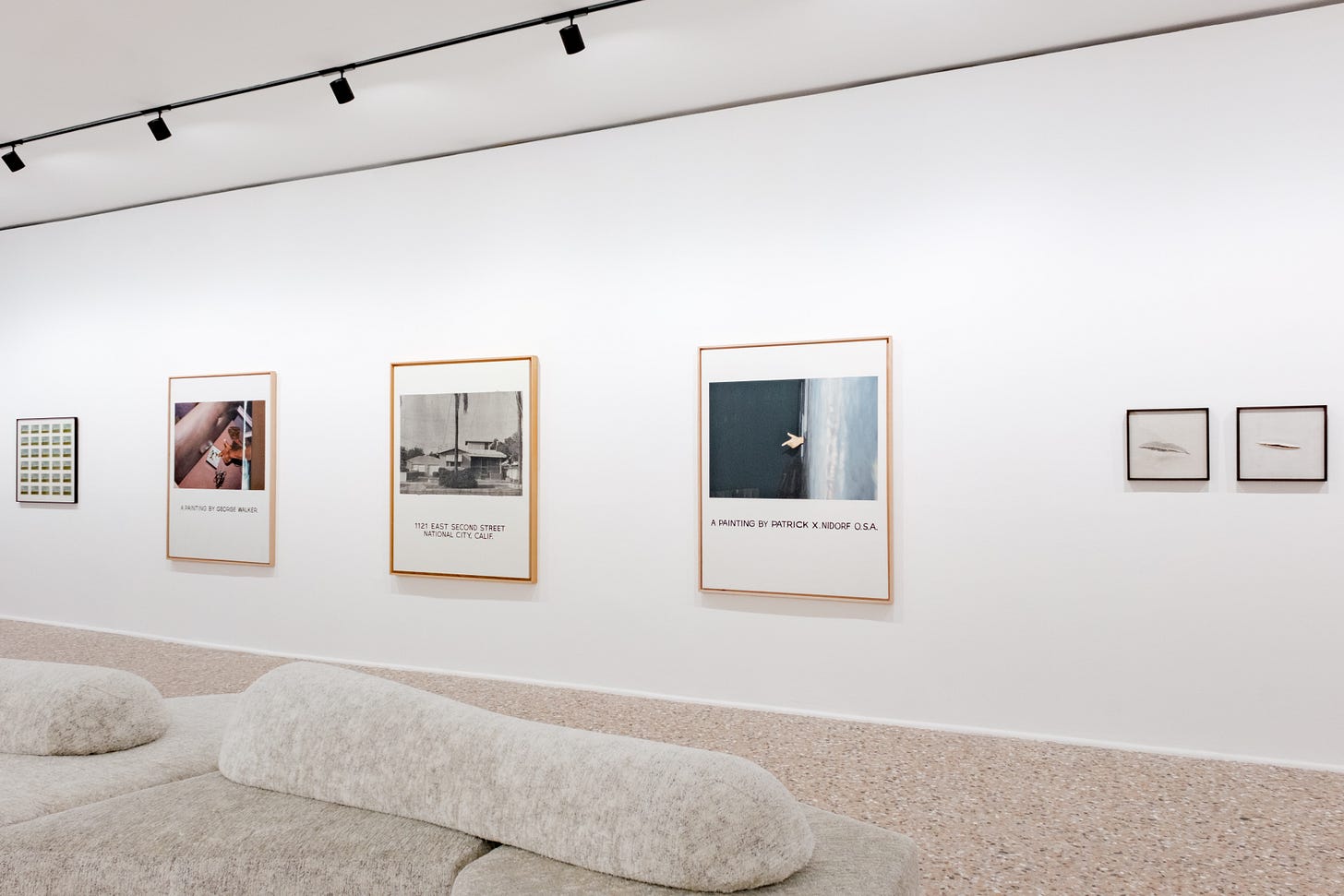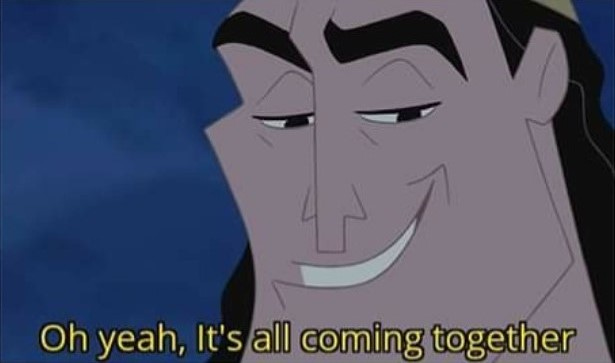The Guy Who Had More Than Concepts of a Plan: John Baldessari at Fondazione Querini Stampalia
Venice gets the biggest solo show on John Baldessari (1931-2020, US-American) it ever had. This is my first deep dive into his art and you know what? Hell yeah.
The first time I (consciously) came across John Baldessari was through a
IG post series with plastic surgery suggestions for famous men in the art world — a clapback to her haters who told her she should look prettier for her age. The second time I bumped into his name was at his Sprüth Magers solo show during Berlin Art Week last year. But I only made the connection at his latest solo show at Fondazione Querini Stampalia here in Venice. And lowkey, I kinda like this guy.According to the press release, the show at Querini Stampalia focuses on the late ‘60s and onward when photography became central to John’s practice. He used to sample pre-existing images from TV and movies, he even had a whole archive dedicated to those samples. He’d often arrange those pictures as cutouts in new compositions. Flying Saucer: Rainbow/Two Cyclists/Dog/Gorilla and Bananas/Chaotic Situation/Couple/Tortoise/Gunman(Fallen) (1992) connects the images in question as a weird chain reaction; their combination is absolutely out of pocket. It’s very much giving surrealist Cadavre exquis where one person adds a new image without knowing the previous one, and the result is unexpected. And there is just something about a cut-out shape following the outlines of its subject that gets me every time.
John walked, so the Picture Generation could run... Honestly, I don’t know why, but referring to him by his first name feels weird, although I do this with artists all the time. It’s like when Carrie says John instead of Mr. Big, there’s something off. And I couldn’t help but wonder: Is John Baldessari perhaps the Mr. Big of the art world? Sorry, I digressed.

When the Concept is Concepting
John (still *yikes*) went down in art history as one of the most important representatives of Conceptual Art. If we keep it very general, Conceptual Art is a genre where the idea is more important than the final object in front of you. But there are two schools of thought emerging from this definition. There is art, where you need a whole lot of external information — and there is no way you could know that by yourself — so your relationship to that artwork is entirely dependent on a text or another outside source giving you that information. I’m looking at you, Massimo Bartolini (Baby Boomer, Italian), don’t piss me off. And then there is conceptual art, where the roadmap for engaging with the artwork is already within the artwork itself. You learn to understand the concept through observation, through analysis, and, yes, there might be a clue or two from another source that might be helpful, but not mandatory. I prefer this latter type.
For example: Two Slices (1966–67) consists of a slit canvas and a photograph of a slit canvas next to it. Is it helpful to know that Lucio Fontana (1899-1968, Italian) began working with his iconic slit canvases in 1958? Sure. But is it necessary to appreciate John’s take? Not at all.
Movement seems to be an important keyword in John’s work. Trying To Roll A Hoop In A Perfect Circle (Best Sequence 216 Frames) (1972-1973) consists of a circle drawn onto the wall and pictures attached on top. The pictures show a drawn circle on the pavement with a hula hoop dropping at different points. The photographs on the wall are arranged around the drawn circle corresponding to their position within the photographed circle. Line of Force (Ball and Hand) (1972/2011) is made up of eight black-and-white photographs of a ball. The pics are cropped to follow the thrown ball in motion across the eight shots, a drawn outline suggests the position of the selected section within the cropped original.

I would also add that Conceptual Art’s playground is a meta level where it gets to ask what makes an art work? In his almost 19-minute-long video I Am Making Art (1972), John repeats the title phrase over and over again, changing the poses and altering his gestures and freezing them until the next phrase repetition. What is the artwork? Is it the video result? Is saying you’re making art the actual production of art? Is he only making art while he’s saying it, freezing the process with the silence in between? Does his making art stop once he stops the recording and does something else? Or is every breath an artist takes art, since all an artist does is produce art? You know what they say: A person who thinks all the time has nothing to think about except thoughts. That quote was most definitely invented by the internet and not Alan Watts (1915-73, British).
Now Picture This:
Given the intensity and attention with which he works with film and television, I’m surprised he never gave movie directing a shot. A simple photographic triptych titled Bird/Plane/Bird (1971) makes me think of that cheesy line in every old-school superhero movie that goes, “Is it a bird? No! Is it a plane? It’s Superman!!!” When he writes captions underneath his Commissioned Painting (1969) series, he goes for a movie font that comes suspiciously close to the Some Like It Hot (1959) movie poster font.
Various Doors (1990) consists of four black-and-white photographs. Each depicts a door being opened, but it’s impossible to see what’s in front of or behind that door. The suspense is sooo Alfred Hitchcock, she said, never having seen one of his films in her life. John draws attention to the hands opening those doors: He painted each slit where the disembodied hand enters the picture in a bold statement color. Only the last photograph on the right lacks a colorful bar. But there’s no hand either: A green picklock sneakily opens that door. The photographs descending in size from left to right and featuring potential burglary is heavily The Daltons from Lucky Luke coded. Go argue with somebody else.

In the ‘70s, John (it’s still weird to call him that) began building narratives based on TV stills. For T.V. Series: 1 Wk. of T.V. Every 10 Min. Ea. Channel from 11 A.M. in Los Angeles Starting Aug 23, 1976 (1976), he did exactly what the title says: Every 10 minutes, he’d freeze the frame of a channel from 11 am until the TV program end for an entire week. I’d argue that back then, there was a different visual culture from today: In 2025, it’s easy to rewatch bits and clips, screenshots from TV shows become memes and therefore more widespread than the show they were taken from. We’re pretty much used to a lack of context. I think it was different back then. The television program back then wasn’t meant to be paused and rewound as much as we’re used to it today. And so John captures shots that weren’t meant for close inspection: overlays, blurry transitions, out-of-context news and scenes, and ads now form a new story like a cartoon sequence.
He makes another step with Three T.V. Sentences (Version 2) (1976), where he chooses a limited set of TV stills and forms a sentence based on the visuals. And this reminds me so much of the emoji filters on social media, where you have to guess a movie title or a phrase based on an emoji combination. It’s fitting, considering that he did actually work with emojis in a later series from 2017, but it’s not included here, though. I lost the plot at the Blasted Allegories (1977-78) series cause he got oddly mathematical and linguistic with it, which doesn’t mean it’s a bad work, my brain simply rebukes maths and syntax analysis.

And then I saw Violent Space Series: Four Spectators To Fight Arranged By Position In Scene (1976): Four black-and-white pictures of the same size arranged on a board. I instantly turned into Leo pointing at that TV screen in Once Upon a Time in Hollywood, and Brian’s research proved me right: John was a professor at CalArts from 1970 until 1988. Sarah Charlesworth’s (1947-2013, US-American) Modern History (1977-2003) series follows a similar approach of decontextualizing and rearranging images and was, according to Met Curator Douglas Eklund, “one of the most frequently discussed bodies of work” at CalArts.1 Mike Kelley (1954-2012, US-American) studied under John and graduated in 1978. And only in 1995, he came up with his Timeless/Authorless series, which now seems to build on both approaches. This is such a full-circle moment.
You know why the exhibition also starts in the ‘60s? Cause there wasn’t much left from before: John burned all his paintings from between 1953 and 1966 to ashes for his Cremation Project (1970). With funerary plaque and all. I guess he took the saying to change yourself, you have to kill your old self, way too literally. And then he made the ashes into cookies and kept them in a custom-made bronze book-shaped urn? This is so unserious, I gotta respect the commitment to the bit. RIP Johnny, you would have loved #everybodysocreative on TikTok.

John Baldessari: No Stone Unturned. Conceptual Photography, until November 23, 2025, at Fondazione Querini Stampalia, Venice.
Fondazione Querini Stampalia
Castello 5252
30122 Venice
Website
Instagram: @fondazionequerinistampalia
So that’s finally my first Venice review of this year! Let me know what you think in the comments, and don’t forget to subscribe if you didn’t already, I appreciate it a lot!
See you soon!!!
Jennifer
The Gen Z Art Critic
Douglas Eklund: “The Artist As Researcher” in: Everything is Connected. Art and Conspiracy. Ex.-Cat. Met Museum, New York 2018, p. 50






Today, I went to Denn's and ate an entire bag of Helix Lakritz Schnecken to myself on the walk home. That's the closest I'm ever going to get to concepting a concept.